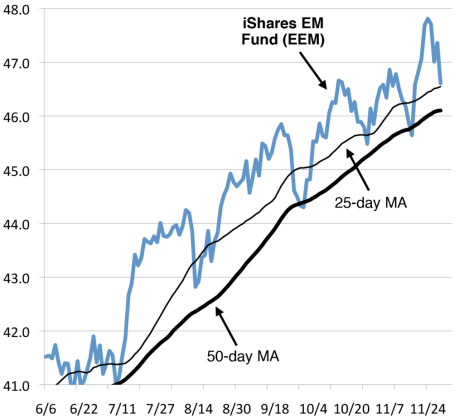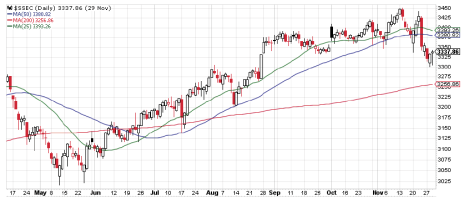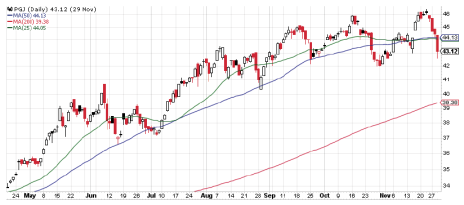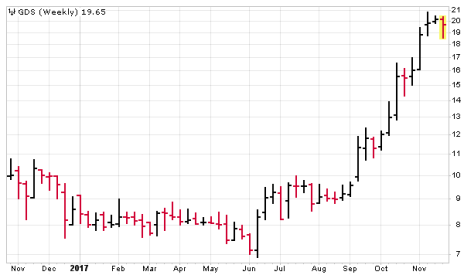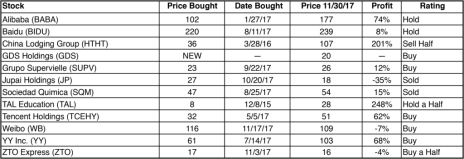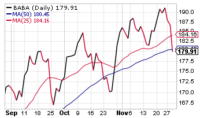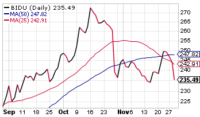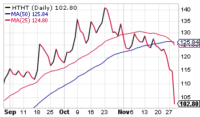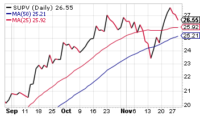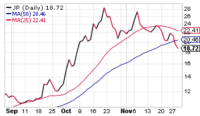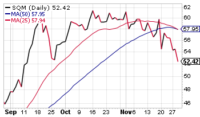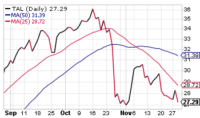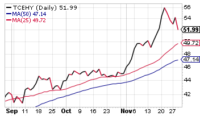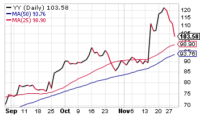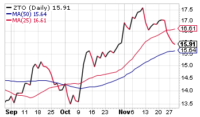In today’s issue, I dig into the reasons behind this painful correction, finding an aggravating Chinese government regulatory shift that can account for a large part. Despite the turmoil, the Cabot Emerging Market Timer is still positive, and I have a fresh, young Chinese tech stock that has enormous potential as the development of the Chinese cloud continues.
Cabot Emerging Markets Investor 647
[premium_html_toc post_id="141878"]
Cabot Emerging Markets Timer
The Emerging Markets Timer is our disciplined method for staying on the right side of the emerging markets. The Timer is bullish when the index is above the lower of its two moving averages and that moving average is trending up.
Our Emerging Markets Timer is still positive, though the choppy, whiplash-type action continues. It’s been a challenging ride for the iShares EM Fund (EEM) since mid-September, with repeated swings up and down, including this week’s dip. But the most important fact is that EEM has remained above its lower (50-day) moving average, which keeps the intermediate-term uptrend intact.
Thus, you should remain bullish overall, but it’s also vital to take things on a stock-by-stock basis—some of our recommendations look just fine, but others have turned ragged after big runs. It’s a good time to cut loose losers and laggards while focusing on resilient stocks.
Policy Risk Comes Home to Roost
The stocks we recommend are always in the form of American Depositary Receipts (ADRs), stocks that trade on U.S. exchanges at a specific ratio to their native shares. So, for instance, while one ADR of Alibaba (BABA) stock equals one native share, an ADR of China Lodging (HTHT) represents four ordinary shares.
The price relationship between shares that trade on one of the three major Chinese stock exchanges (Shanghai, Shenzhen and Hong Kong) and the ADRs that trade on the NYSE and the Nasdaq isn’t rigid, partly because Chinese and U.S. exchanges aren’t open at the same time. But while the ratio of ADR to native share stays roughly constant, there can be periods when values diverge.
We’ve had years when Chinese stocks were being tossed in the surf all year and our ADRs were doing fine. Where we usually see influence is when a major correction on Chinese exchanges hits the value of ADRs, which is what’s happening now.
This relationship between Chinese and U.S. share prices has been more important in the past week or so because stocks on the Chinese exchanges have had some hairy corrections caused by a government crackdown on lending behavior.
The Chinese lending industry is a multifarious beast that includes enough shadow banking, black pools and downright off-the-books illegality to give regulators an ulcer. Ineffective controls on lending have contributed to a couple of dangerous bubbles in the Chinese economy, including an overheated rally in the stock market that burst in 2015 (after some ham-handed government regulation) and a longer-term problem with real-estate speculation.
The recent decline in the Chinese stock market is being caused by a rout in the bond market that has pushed yields on Chinese government bonds to three-year highs. The higher yields are seen as likely to make it more expensive for both corporations and individuals to refinance debt, which will cut into corporate profits and increase the danger from China’s debt bubble. Here’s what the correction has looked like on the Shanghai Exchange. (The Shanghai Composite is now back to August levels.)
The Shenzhen Exchange’s cumulative index is in similar shape, but, interestingly, the Hong Kong exchange’s Hang Seng Index has been nicked only slightly, insulated from the downtrend by Hong Kong’s freer access to international capital sources.
And while the PowerShares Golden Dragon China ETF (PGJ) that tracks all Chinese ADRs has been under pressure, it wasn’t until Wednesday’s over-the-falls action that PGJ fell below its 25- and 50-day moving averages.
Having an explanation is intellectually gratifying and will have some effect on how we handle our shares. But the intermediate-term trend of the market itself is the most important thing, and with the Cabot Emerging Markets Timer still flashing a green light, we will keep a steady hand on the tiller and manage our stocks on an individual basis. We have already cut two of our underperforming holdings loose, and if our timing indicator turns negative, we will also curtail most new buying and tighten the stops on our current holdings. We’ll let you know.
Featured Stock
Building Out the Cloud
GDS Holdings (GDS)
It’s easy to see the opportunities in China’s national tech giants like Alibaba, Baidu and Tencent Holdings. But once you own those headline makers, the next step isn’t so obvious.
Here it is.
GDS Holdings (GDS) is a Chinese company in the data center business, and its carrier-neutral, cloud-neutral facilities allow connections to all major Chinese telecommunications carriers and to many financial services companies and large enterprises. Founded in 2001 as a business continuity and disaster recovery vendor, the company relied initially on third-party data centers.
But starting in 2009, the company started building big data centers of its own in key locations and courting users who needed substantial capacity and power. In 2011, GDS established new data centers in Kunshan, Chengdu and Shanghai, followed by its first Shenzhen data center in 2014 and two new centers in Beijing and Shanghai in 2015. (Data center capacity and customer utilization is measured in square meters)
2016 was a big year for GDS Holdings, as it powered up four new data centers and came public on the Nasdaq exchange on November 2.
GDS Holdings isn’t an earnings story, at least not yet. The company enjoyed revenue growth of 47% in 2015, 42% in 2016 and 56%, 40% and 43% in the first three quarters of 2017, respectively. But the price of building data centers is enormous, and while adjusted EBITDA was up over 70% in Q3, nobody expects GDS to turn profitable anytime soon.
The story here is growth, and a client list that includes major players like Alibaba and Tencent Holdings (who accounted for 45% of total revenue in 2016). The company also expects to start hosting Baidu’s cloud platform (and their traditional search business) in the fourth quarter. Including the 6,000 square meters gained in Q3, GDS Holdings added over 21,000 square meters of new customer commitments so far in 2017 and the company expects to end the year with $120 million of new bookings. After adding nine new customers in Q3, GDS has 496 customers and has six new data centers under construction.
The company announced a few weeks ago that it had acquired a second data center in Guangzhou that is fully committed and used by a big internet customer. That takeover just closed. And since customer churn in the third quarter was just 0.1%, the future visibility of that revenue stream seems secure.
As if all that growth weren’t enough, GDS Holdings has so far concentrated exclusively on Tier 1 Chinese cities, leaving the entire Tier 2 and Tier 3 landscape open for expansion. And just for an extra, the company gets 10% of its revenue from customers outside China, and with its highly connected data interchange structure, GDS will be an attractive partner for more non-Chinese firms.
GDS came public at 10 a little over a year ago and went through a routine post-IPO correction to just below 7 in June 2017. The stock bounced to just below 10 in July, took a little break through the end of August, then blasted off on heavy volume (but no apparent news) on November 11. The stock climbed steadily through October and November, with frequent volume spikes on advancing days. It closed for the first time above 20 on November 20, and pulled back by less than a point during the Wednesday meltdown. This correction looks like an advantageous buy point. BUY.
GDS Holdings Limited (GDS 20)
Youyou Century Place
2nd Floor, Tower 2
Shanghai 200127
China
86 21 2033 0303
www.gds-services.com
Model Portfolio
Invested 85% Cash 15%
Updates
The choppy environment for emerging market stocks remains in place, with three-steps-forward, two-steps-back action occurring every couple of weeks. Our Emerging Markets Timer is still bullish, so we’re still maintaining a generally optimistic point of view.
That said, we’re also focused on the action of our stocks, and on that front, the message is relatively mixed—some act just fine and look like good buys, others are acting iffy (or worse).
In a Special Bulletin yesterday, we sold our half positions in both Jupai (JP) and Sociedada Quimica y Minera (SQM). Tonight, we’re moving Alibaba (BABA) to Hold and ChinaLodging (HTHT) to Sell Half.
Longer-term, we still think Alibaba (BABA) has a lot of upside ahead, given its leadership position, one-of-a-kind growth story and the fact that it broke out of a multi-year base this spring. However, intermediate-term, the stock looks iffy, as it hasn’t outperformed the market during the past three months and, this week, saw another bout of heavy selling. We think it’s prudent to shift our rating to Hold here; much more weakness could have us booking partial profits. HOLD.
Baidu (BIDU) looked like a goner during the day yesterday, but, for the third time since late-October, the stock found support in the 230 area. There is some hubbub about the firm’s driverless cars, which reportedly are already being tested, but in the near-term, BIDU will be driven by sentiment surrounding China as a whole and the company’s search business. We continue to hold with a tight mental stop. HOLD.
Fundamentally, China Lodging Group (HTHT) continues to have a story that’s easy to enthuse about. Last week, the company reported that third-quarter sales (up 34%) and earnings (up 58%) grew handsomely, while management said fourth-quarter revenue is likely to rise north of 30%. Analysts have bumped up their estimates and now see earnings up 37% next year. That said, the company is not the stock, and HTHT has slid sharply in recent days, breaking intermediate-term support. Long-term, we still have high hopes, but there’s no question that this stock has had a huge, huge advance, and the recent action increases the odds that shares need time to build a new launching pad. We’ll sell half our shares here and give the rest some room to consolidate. SELL HALF, HOLD THE REST.
Grupo Supervielle (SUPV) looks totally fine, having recovered to new highs after its shakeout earlier this month (its first dip to its 50-day line since breaking out in August), and the dip this week has been normal. Hang on if you own some, and if you don’t, you can pick up shares here. BUY.
Jupai Holdings (JP) was sold on last night’s Special Bulletin. It could bounce if Chinese stocks do, but the big retreat during the past few weeks is abnormal. We think it’s best to sell your half position. SOLD.
Sociedad Quimica y Minera (SQM) was also cut loose last night, as the stock’s sluggishness became too much to ignore—as of yesterday’s close, hadn’t made any net progress in about four months. Of course, we do like the lithium story and could revisit SQM sometime in the future, but given the tricky market environment and the stock’s action, we sold our half position. SOLD.
TAL Education (TAL) continues to meander below its 25-day line and is close to its post-earnings support level. The company has been quiet on the news front, and the fundamental story remains just fine. We’ll continue to give our remaining shares an opportunity to wear out the sellers and resume their longer-term advance. HOLD A HALF.
Tencent Holdings (TCEHY) has finally begun to take a breather after a short-term climactic move higher after earnings two weeks ago—shares have been advancing all year, and last week, moved out of trend on the upside, which usually precedes a pullback. We’re not opposed to taking partial profits if you want, but to this point, TCEHY’s retreat isn’t even down to its 25-day line, and overall, the stock is holding up better than most of its peers. Plus, the story doesn’t get much better. We’ll stay on Buy, thinking that buying here (if you’re not yet in) should work out over time. BUY.
Weibo (WB) has pulled back in recent days, but it still looks like a good Buy to us—the stock retested the top of its September-October base (and its 25-day line) and closed nicely above those levels. There aren’t many bigger growth stories out there. BUY.
YY Inc. (YY) was looking fantastic before the China selloff yanked it lower in recent days. Still, despite the volatility, volume on the dip wasn’t overwhelming and shares are above even their short-term moving averages. A dip below 95 would be a yellow flag, but right now, the odds favor this being a normal retreat. BUY.
ZTO Express (ZTO) has chopped lower since tagging 18 nearly three weeks ago. It’s not ideal, but we think it’s OK, as volume on the decline has been below average and the stock has found support near its 50-day line. Analysts see earnings up 32% next year, and we think that could prove conservative. Go ahead and buy a half-sized stake if you’re not yet in. BUY A HALF.
[premium_html_footer]
Send questions or comments to paul@cabotwealth.com.
Cabot Emerging Markets Investor • 176 North Street, Salem, MA 01970 • www.cabotwealth.com
All Cabot Emerging Markets Investor buy and sell recommendations are made in issues or updates and posted on the Cabot subscribers’ website. Sell recommendations may also be sent to subscribers as special alerts via email. To calculate the performance of the hypothetical portfolio, Cabot “buys” and “sells” at the midpoint of the high and low prices of the stock on the day following the recommendation. Cabot’s policy is to sell any stock that shows a loss of 20% in a bull market (15% in a bear market) from our original buy price, calculated using the current closing (not intra-day) price. Subscribers should apply loss limits based on their own personal purchase prices.
THE NEXT CABOT EMERGING MARKETS INVESTOR ISSUE IS SCHEDULED FOR December 14, 2017
We appreciate your feedback on this issue. Follow the link below to complete our subscriber satisfaction survey: Go to: www.surveymonkey.com/chinasurvey
Cabot Emerging Markets Investor is published by Cabot Wealth Network, an independent publisher of investment advice since 1970. Neither Cabot Wealth Network, nor our employees, are compensated in any way by the companies whose stocks we recommend. Sources of information are believed to be reliable, but they are in no way guaranteed to be complete or without error. Recommendations, opinions or suggestions are given with the understanding that subscribers acting on information assume all risks involved. © Cabot Wealth Network 2017. Copying and/or electronic transmission of this report is a violation of the copyright law. For the protection of our subscribers, if copyright laws are violated, the subscription will be terminated. To subscribe or for information on our privacy policy, visit www.cabotwealth.com, write to support@cabotwealth.com or call 978-745-5532.
[/premium_html_footer]

